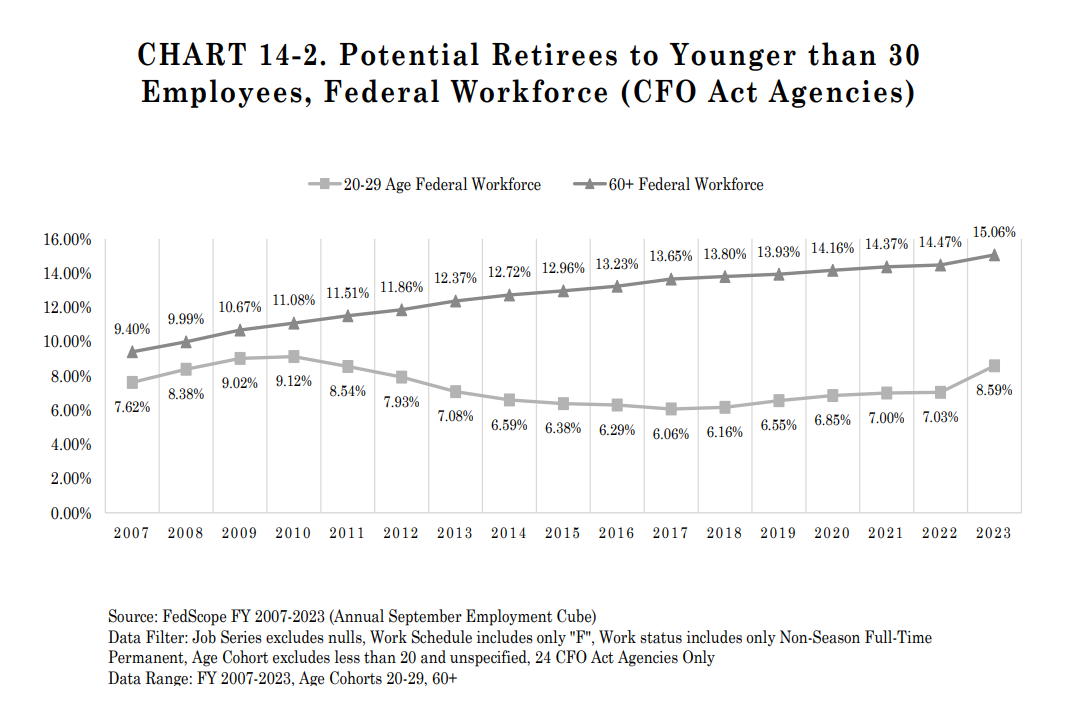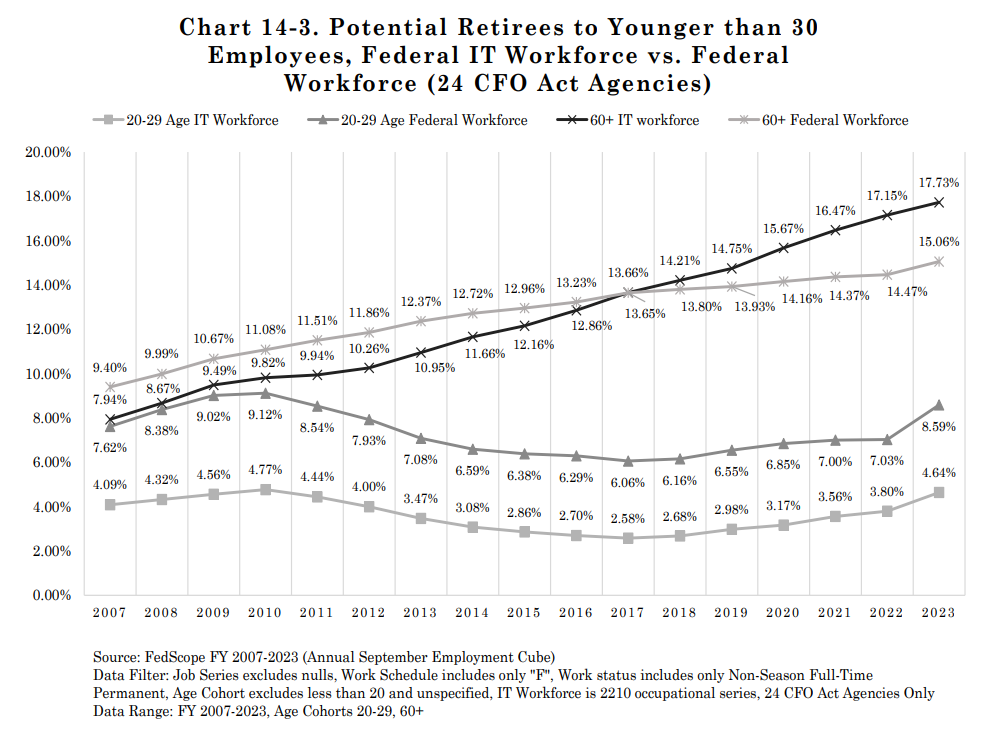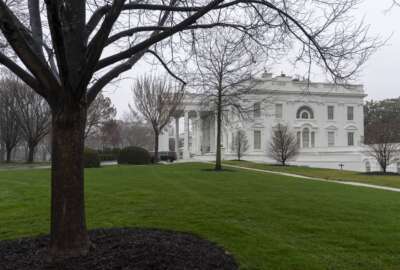OPM prioritizing pooled hiring, HR workforce in 2025 budget
OPM’s request for $465.8 million in discretionary fiscal 2025 spending looks to scale up development of early-career talent, the HR workforce and more.
After a 5.2% civilian federal pay raise in 2024, the White House’s new proposal of a 2% boost for next year unsurprisingly drew pushback from some federal unions, organizations and employees.
But under the surface of the fiscal 2025 budget request, other long-term plans for federal workforce reform from the Biden administration are emerging.
The Office of Personnel Management is requesting bigger investments to continue prioritizing many strategies aiming to strengthen recruitment and retention of the federal workforce.
For 2025, the Biden administration is proposing $465.8 million in discretionary spending for OPM. It’s an increase of nearly 21% over OPM’s enacted discretionary budget of $385.7 million in 2023.
Agency spending for 2025, of course, won’t be determined for quite some time. Congress still hasn’t passed 2024 appropriations for OPM.
But over the next several months, pooled hiring is expected to scale up significantly, according to the OPM’s 2025 budget request.
“The funding would expand agencies’ use of USAJobs agency talent portal’s talent pools feature; support pooled hiring actions to drive a tech talent surge in AI, AI-enabling roles, cyber, data and other technology and associated enabling roles; and further promote the robust sharing of certificates and cross-agency coordination on hiring,” OPM said in its congressional budget justification.
Pooled hiring is a recruitment strategy that’s been available to agencies for the better part of a decade — but up to this point, agencies haven’t used it to its full extent.
By this September, OPM is planning to either lead or help facilitate a combined 28 pooled hiring efforts for agencies, ideally yielding 700 new federal hires.
In 2023, four agencies shared seven hiring actions, leading to another 93 pooled hiring selections across nine agencies, the Office of Management and Budget said in a budget request document. The budget request would help scale up the use of the hiring practice, OPM said, after agencies successfully used the strategy to help them hire thousands of new employees under the Infrastructure Investment and Jobs Act.
Pooled hiring this calendar year has already taken off. In the past few months, OPM has launched new pooled hiring initiatives targeting positions in IT and data management, the Biden administration reported in its latest President’s Management Agenda quarterly update.
“These approaches allow qualified candidates to submit one application that opens doors to roles across all agencies,” the PMA update said.
Investing in the HR workforce
While pooled hiring can help job applicants get their resume in front of more than one agency at a time, the strategy can also ease the burden for federal HR staff. It’s just one example of how OPM is putting the government’s 47,000 HR professionals in the spotlight as part of its latest budget request.
The subsection of the federal workforce has long been under-resourced, but many federal workforce experts say but with the right attention, HR employees could support the improvement of government hiring overall.
“Although the need to improve strategic human capital management has been cited repeatedly by the Government Accountability Office as a high risk to federal operations, to date federal HR workforce development has not received prioritization and resourcing commensurate with their critical value to hire, retain, develop and engage a high-quality workforce for the rest of government,” OPM said.
An annual survey from the General Services Administration shows that satisfaction with human capital services in government consistently ranks last among internal agency operations such as financial management, acquisition and IT, OMB said in a budget document.
“Attrition and difficulty with hiring has compounding effects because the absence of HR staff adds time and complexity to the hiring process to backfill HR positions and other critical occupations,” OMB said.
For 2025, OPM is looking to scale up investments specifically in the HR workforce and seeking statutory authority over workforce developments in the HR sector. Along with cybersecurity and acquisition, HR is a major area that still has governmentwide skills gaps at agencies.
“Following the successful precedent set to address skills gaps in the federal acquisitions workforce, OPM seeks the ability to carry out governmentwide, coordinated activities to build the capacity and capabilities of the federal HR workforce,” OPM said.
To try to support federal HR, OPM is seeking to build on some initiatives it’s already started. For instance, OPM has drafted a new career pathing model for the federal HR workforce and launched a pilot of the new model at nine agencies. In 2025, the goal is to expand the pilot to more agencies.
OPM said it’s also beginning to develop more online tools for HR employees to use, including an HR career growth website. The website will eventually include HR workforce training and career development resources and leading practices, OPM said in its recent workforce of the future playbook.
Early-career recruitment goals
The widening age gap in the federal workforce is prompting the White House to seek further investments in early-career recruitment and retention strategies.
Currently, about 8.6% of the federal workforce is under age 30, according to the latest data from OMB and OPM. By comparison, about 20% of the nationwide workforce is under 30 years old.
At the same time, more than 28% of the federal workforce is over age 55 — with the average age of a federal employee being 47 years old.

It’s a trend agencies have been trying to improve for years, but despite a slight recent change, the age gap has continued to widen since 2007, OMB said.
The gap is even larger when considering specific fields in government. The federal IT workforce, notably, trends older than the federal workforce overall.

The Biden administration said it’s aiming to mitigate the problem through a number of strategies. OPM, for instance, is updating the Pathways Program — a decade-old program intended to help bring more young employees into full-time federal positions. Over the last year, OPM has also created a federal internship portal on USAJobs and stood up an intern experience program.
“The decline in the federal workforce under the age of 30 became more acute after 2010, when federal internships and hiring programs for recent graduates became subject to new restrictions,” OMB said.
Part of the challenge for agencies has also historically been with trying to convert Pathways Program interns and other early-career temporary employees into full-time federal service.
OPM said its funding request would be put toward developing rotational opportunities for early-career talent, creating a mentoring program for younger talent in government, and looking for ways to expand paid internship opportunities.
More generally, agencies should also revisit how interns are perceived and positioned within agencies — viewing them as potential long-term contributors, rather than temporary assets, OPM said in the workforce of the future playbook.
In the playbook, OPM touted some agencies as success stories of early-career recruitment and retention. NASA, for instance, brought on more than 3,500 paid interns, and has converted 84% of those early-career workers into full-time employees. And in the internship program at the Nuclear Regulatory Commission, all interns are paid, including funding for travel and a stipend.
In one effort bridging some of the 2025 budget priorities, OPM said it plans on piloting a governmentwide HR internship program.
“Making the federal government a model employer is a multi-year effort, and OPM has built momentum toward this goal,” OPM said. “OPM will identify additional promising hiring practices that can be scaled to address mission critical skills gaps and deploy new features in talent acquisition systems to improve HR and hiring managers’ experience.”
Copyright © 2025 Federal News Network. All rights reserved. This website is not intended for users located within the European Economic Area.
Drew Friedman is a workforce, pay and benefits reporter for Federal News Network.
Follow @dfriedmanWFED






